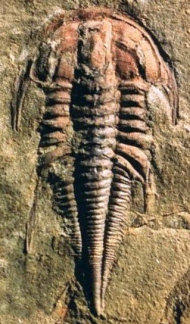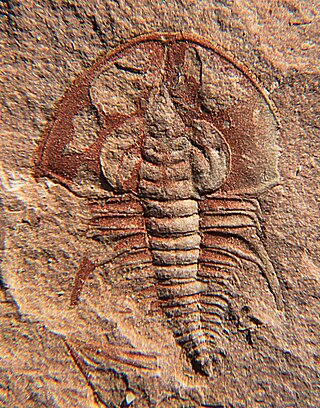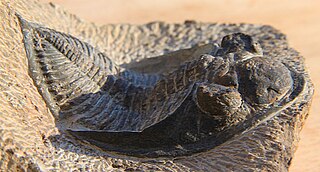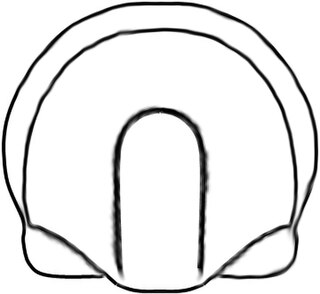
Trilobites are extinct marine arthropods that form the class Trilobita. Trilobites form one of the earliest known groups of arthropods. The first appearance of trilobites in the fossil record defines the base of the Atdabanian stage of the Early Cambrian period and they flourished throughout the lower Paleozoic before slipping into a long decline, when, during the Devonian, all trilobite orders except the Proetida died out. The last trilobites disappeared in the mass extinction at the end of the Permian about 251.9 million years ago. Trilobites were among the most successful of all early animals, existing in oceans for almost 270 million years, with over 22,000 species having been described.

Redlichiida is an order of trilobites, a group of extinct marine arthropods. Species assigned to the order Redlichiida are among the first trilobites to appear in the fossil record, about halfway during the Lower Cambrian. Due to the difficulty to relate sediments in different areas, there remains some discussion, but among the earliest are Fallotaspis, and Lemdadella, both belonging to this order. The first representatives of the orders Corynexochida and Ptychopariida also appear very early on and may prove to be even earlier than any redlichiid species. In terms of anatomical comparison, the earliest redlichiid species are probably ancestral to all other trilobite orders and share many primitive characters. The last redlichiid trilobites died out before the end of the Middle Cambrian.

The Phacopina comprise a suborder of the trilobite order Phacopida. Species belonging to the Phacopina lived from the Lower Ordovician (Tremadocian) through the end of the Upper Devonian (Famennian). The one unique feature that distinguishes Phacopina from all other trilobites are the very large, separately set lenses without a common cornea of the compound eye.

Phacopidae is a family of phacopid trilobites that ranges from the Lower Ordovician to the Upper Devonian, with representatives in all paleocontinents.

Emuellidae are a small family of trilobites, a group of extinct marine arthropods, that lived during the late Lower Cambrian of the East Gondwana supercontinent, in what are today South-Australia and Antarctica.

Olenellina is a suborder of the order Redlichiida of trilobites that occurs about halfway during the Lower Cambrian, at the start of the stage called the Atdabanian. The earliest trilobites in the fossil record are arguably Olenellina, although the earliest Redlichiina,Ptychopariida, and Eodiscina follow quickly. The suborder died out when the Lower Cambrian passed into the Middle Cambrian, at the end of the stage called Toyonian. A feature uniting the Olenellina is the lack of rupture lines in the headshield, which in other trilobites assist the periodic moulting, associated with arthropod growth. Some derived trilobites have lost facial sutures again, but all of these are blind, while all Olenellina have eyes.

Huntoniatonia is genus of trilobites, an extinct group of marine arthropods of average to large size.
Meniscuchus is an extinct genus from a well-known class of fossil marine arthropods, the trilobites. It lived during the Botomian stage, which lasted from approximately 522 to 516 million years ago. This faunal stage was part of the Cambrian Period. Meniscuchus has been found in the USA, Canada, Russia and Australia.

Dicerodiscus is an extinct genus from a well-known class of fossil marine arthropods, the trilobites. It lived during the early part of the Botomian stage, in China. Four species have been assigned to it. Dicerodiscus is unique for an eodiscoid in having conspicuous and curved spines that are attached anteriorly, and at their base are directed outward perpendicular to the midline, before gradually bending further backwards.
Resserops is an extinct genus from a well-known class of fossil marine arthropods, the trilobites. It lived during the middle of the Atdabanian or the early part of the Botomian stage, which lasted from approximately 524 to 518.5 million years ago. This faunal stage was part of the Cambrian Period. It has been found in Spain and southern Morocco. It can be recognised by the sabre-like spines of the headshield that are a smooth continuation of the frontal edge, and the enlarged spines on the 9th segment of the thorax.

Yunnanocephalus is a genus of ptychopariid trilobite. It lived during the late Atdabanian and Botomian stages, in what are currently Antarctica, Australia and China. It was a "moderately common" member of the Chengjiang Fauna. Yunnanocephalus is the only genus currently assigned to the Yunnanocephalidae family.

Tsunyidiscus is a trilobite belonging to the Suborder Eodiscina. Tsunyidiscus appeared near the end of the Lower Cambrian, during the late Atdabanian stage of geologic time and some collections suggest it may have survived into the Botomian. The genus is very small, oculate and isopypous with a narrow dome-shaped glabella and a narrow bullet-shaped pygidial axis. Thorax consists of three segments. Tsunyidiscus is the only genus currently attributed to the family Tsunyidiscidae.
Acmarhachis is a genus of trilobite in the order Agnostida, which lived in what are now Australia, Canada, China (Anhui), Kazakhstan, Russia (Kharaulakh), and the US. It was described by Resser in 1938, and the type species is Acmarhachis typicalis.
Lotagnostus is a genus of very small trilobites in the order Agnostida, which lived on the outer continental shelves worldwide, during the late Upper Cambrian. It was described by Whitehouse in 1936, and the type species is Lotagnostus trisectus, which was originally described as a species of Agnostus by Salter in 1864.

Odontochile is a genus of trilobites in the order Phacopida, family Dalmanitidae.

Richterops is an extinct genus of trilobite arthropods. The genus lived during the middle of the Atdabanian or the early part of the Botomian stage, which lasted from approximately 524 to 518.5 million years ago. This faunal stage was part of the second half of the Lower Cambrian. It has been found in southern Morocco. It can be recognised by the long spines of the headshield that are a smooth continuation of the frontal edge, and the enlarged spines on the 11th segment of the thorax.

Mallagnostus Howell, 1935, is a trilobite genus belonging to the family Weymouthiidae Kobayashi T. (1943), Order Agnostida Salter (1864) according to Whittington et al. 1997. It lived during the late Lower Cambrian, with remains found in USA, Canada (Newfoundland), Spain, England, Russia, Mongolia, and the early Middle Cambrian as reported from China and Russia (Yakutia).

Galbagnostus is an extinct genus of agnostid trilobite. It lived during the Lower and Middle Ordovician.

The Peronopsidae comprise the earliest family of the Agnostina suborder. Species of this family occurred on all paleocontinents. The earliest representatives of this family first occur just before the start of the Middle Cambrian, and the last disappeared just after the start of the Upper Cambrian.

The Hebediscidae Kobayashi, 1944, are a family of trilobites belonging to the order Agnostida that lived during the Lower Cambrian. They are small or very small, and have a thorax of two or three segments. The Hebediscidae include five genera.


















